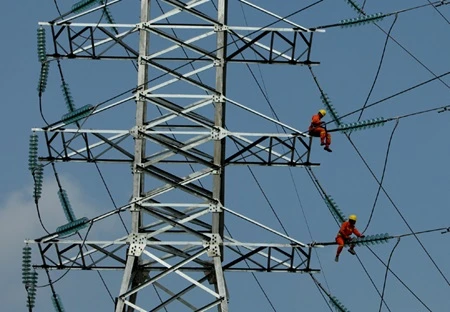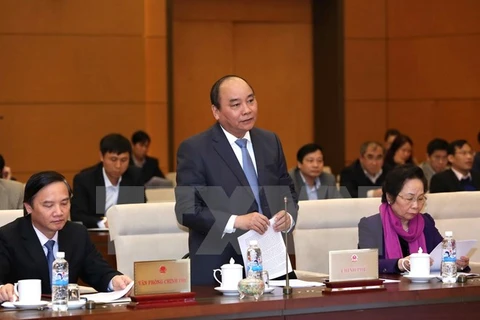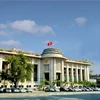 Nguyen Tan Dung (sixth, left) and other Government members pose for a photo at the Cabinet's March meeting, which is also the last he chaired on the position of the Prime Minister (Photo: VNA)
Nguyen Tan Dung (sixth, left) and other Government members pose for a photo at the Cabinet's March meeting, which is also the last he chaired on the position of the Prime Minister (Photo: VNA) Hanoi (VNA) – Despite shortcomings, the Government has secured noteworthy achievements in the last five years, which reflected the leadership quality of the 2011-2016 tenure.
Throughout the first half of the tenure, the Government faced numerous difficulties. The national sovereignty at sea was threatened. The economy entered a downturn with nearly collapsed banking system, the burst real estate bubble, and unstable gold and currency markets. The transport infrastructure proved insufficient and natural disasters, particularly drought, took their toll.
The 2006-2010 period formed a weak foundation for the economy in the 2011-2016 period. At a shifting point between the two periods, a gloomy global economy had its impact on Vietnam where inflation was skyrocketing as a result of previous economic policy on recession prevention. Overall, Vietnam’s economy had a low level of competitiveness and quality.
In that context, the Government issued Resolution 11/NQ-CP/2011 focusing on measures to curb inflation, stabilise the macro economy and ensure social welfare. The timely resolution became an important turning point and a lodestar for the Government’s management throughout the tenure.
According to Vuong Dinh Hue, a legislator from the central province of Binh Dinh, the issuance of Resolution 11/NQ-CP/2011 was a highlight in the early period of the tenure as it cut public spending to reduce inflation and stabilise the macro economy .
If the Government had not been committed to the task, such good outcomes today would not have been achieved, Hue stressed.
Others said the main characteristic of this period was the Cabinet’s commitment to macroeconomic stabilisation and economic restructuring. The Government worked to remove difficulties for businesses and improve the local business climate and competiveness for sustainable development and deeper global integration.
Sparing no effort, the Government ended its 2011-2016 tenure with impressive records. The consumer price index (CPI) decreased from 18.13 percent in 2011 to 0.6 percent in 2015, the lowest rate recorded since 2001 (the CPI goal set for 2015 by the National Assembly (NA) was between 5 and 7 percent). The average economic growth rate over the five-year period hit more than 5.9 percent. In 2015 alone, Vietnam grew 6.68 percent, its highest growth since 2008.
Do Van Ve, a NA deputy from the northern province of Thai Binh, said the last tenure’s success was based on the flexiblity of the Government and the Prime Minister, which led to a relatively high growth rate of 5.9 percent, given a widespread slowdown in the global economy at this time.
In the 2011-2016 tenure, the Government was also dedicated to overhauling administrative procedures, improving the business climate and attracting investment. Resolution 19/NQ-CP dated March 18, 2014 and Resolution 19/NQ-CP issued on March 12, 2015 represented changes towards a more open-minded and equitable management of the Government in line with the 2013 amended Constitution. Both resolutions offered new approaches to administrative reform and business climate improvement, in a bid to help Vietnam elevate its global position in trade and investment.
Chairman of the Vietnam Chamber of Commerce and Industry (VCCI) Vu Tien Loc said the tenure, particularly with its two resolutions, had succeeded in kickstarting a breakthrough period of institutional restructuring.
Latent in these achievements was the burden of public debt and an imbalance in the State budget.
In 2015, for the first time, budget spending surpassed 1.2 thousand trillion VND (54 billion USD). Statistics from the Ministry of Finance showed that public debt, government debt and external debt accounted for 62.2 percent, 50.3 percent and 43.1 percent of GDP, respectively. As such, government debt surpassed its quota by 0.3 percent.
The ministry said the high level of government debt was caused by plunging real GDP and the disbursement of 30 trillion VND (1.35 billion USD) worth of ODA and other foreign loans in 2015.
Deputy Tran Ngoc Vinh from the northern city of Hai Phong proposed that the Government should tighten its monitor of loan distribution and use in localities to restrict public debt increases.
Policies to boost the business potential of domestic enterprises, attract idle capital and effectively restructure public debt are needed, he noted.-VNA


























